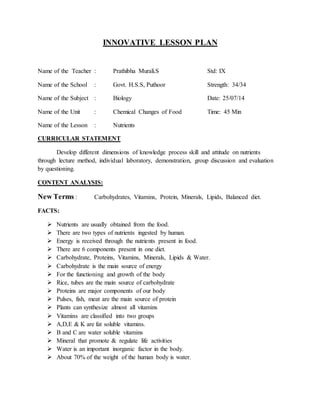
Innovative lesson plan
- 1. INNOVATIVE LESSON PLAN Name of the Teacher : Prathibha Murali.S Std: IX Name of the School : Govt. H.S.S, Puthoor Strength: 34/34 Name of the Subject : Biology Date: 25/07/14 Name of the Unit : Chemical Changes of Food Time: 45 Min Name of the Lesson : Nutrients CURRICULAR STATEMENT Develop different dimensions of knowledge process skill and attitude on nutrients through lecture method, individual laboratory, demonstration, group discussion and evaluation by questioning. CONTENT ANALYSIS: New Terms : Carbohydrates, Vitamins, Protein, Minerals, Lipids, Balanced diet. FACTS: Nutrients are usually obtained from the food. There are two types of nutrients ingested by human. Energy is received through the nutrients present in food. There are 6 components present in one diet. Carbohydrate, Proteins, Vitamins, Minerals, Lipids & Water. Carbohydrate is the main source of energy For the functioning and growth of the body Rice, tubes are the main source of carbohydrate Proteins are major components of our body Pulses, fish, meat are the main source of protein Plants can synthesize almost all vitamins Vitamins are classified into two groups A,D,E & K are fat soluble vitamins. B and C are water soluble vitamins Mineral that promote & regulate life activities Water is an important inorganic factor in the body. About 70% of the weight of the human body is water.
- 2. MINOR CONCEPT: 6 components are present in one diet that are carbohydrate, protein, lipid, vitamin, minerals & water. The nutrient ingested by human beings can be decided into macronutrients and micro-nutrients. MAJOR CONCEPT: Nutrients are chemical substances needed by the body for growth, maintenance, repair and reproduction. LEARNING OUTCOMES IN TERMS OF SPECIFICATIONS. 1. Factual Knowledge: a. Retrieving the new terms like carbohydrate , lipids…. b. Identifying the different content of the nutrients of the specimen. c. Explaining the functions of the different content of the nutrients. 2. Conceptual knowledge a. Retrieving the functions of nutrients b. Identifying the inter relationship of different nutrients c. Explaining the functions of nutrients d. Comparing the functions of carbohydrate proteins, lipids etc. 3. Procedural knowledge a. Differentiating the contents of nutrients in terms of growth and development b. Comparing the nutrients included in homely food and fast food. 4. Meta cognitive knowledge a. Identifying the functions of different contents of a nutrients b. Detecting the nutrients content food that we can use our daily life. 5. Scientific attitude towards the importance and function of nutrients 6. Process Skills a. Observing the function of each nutrients b. Communicating the ill effects of Mal nutrients through discussions PRE- REQUISITES Nutrition is one of the important life process taking place in all living organisms that is animal and human being. Different parts of animal and human being are adapted to carry out its functions.
- 3. TEACHING – LEARNING RESOURCES 1. Chart and Models 2. Specimens 3. References Book: NCERT, SCERT- Text book of Class IX CLASSROOM INTERACTION PROCEDURE EXPECTED PUPIL RESPONSE Teacher make rapport with students, What can you get when we consume food? What is the function of it? Growth and energy consumption which material will help us? Teacher groups the Students Ask which type of Food items you can eat early morning PHASE I: CONCEPT FORMATION LISTING Which type s of food you like? What are the ingredients we can use to prepare “Chapatti”? What are the ingredients added on chicken Curry? GROUPING Group them into the components LABELLING Group the Food items based on their functions Energy Helps our normal life activities Nutrients Dosa, Chappatti etc. Dosa, Chappatti, Idali, Rice etc Wheat flour, water, Salt, Ghee, Oil Masala, chicken, Oil, Onion etc A B C D E Rice Wheat Fish Egg Meat Oil Ghee Leafy Vegetables Salt A- Carbohydrate B- Protein C- Lipids D- Vitamins E- Minerals
- 4. PHASE II : INTERPRETING OF DATA COMPARING What are the common features of the group A,B, C,D&E ? EXPLAINING a. Carbohydrate - Sources of carbohydrate are Rice, Tubers etc Function -Energy Production b. Protein – Peas , Fish etc are the main source Function -Building up of Body tissues A- Carbohydrate is the main sources of energy B- Protein helps us to building up of body tissues C- It is used for the production the energy D&E- Promote and regulate life activities
- 5. c. Lipids- Oil, Ghee etc are the main source Function – Energy Production d. Vitamins- Fruits, Leafy Vegetables etc. are the main source Function- Control Life Activities. e. Minerals- Salt, Garlic etc are the main sources Function- helps and control life activities GENERALISING Concluded the components of nutrients Water is also nutrients PHASE III- APPLICATION OF GENERALISATION Predicting What is the result of deficiency of nutrients in our food? Supporting the Prediction Why this disease causes? Causes diseases Due to the deficiency of nutritious food
- 6. REVIEW 1. What are nutrients? 2. What is the function of carbohydrate? 3. Which is the sources of lipids? 4. What is the function of vitamins & minerals? 5. What is the function of protein? FOLOW UP ACTIVITY Write a note on nutrient deficiency diseases in your science diary?